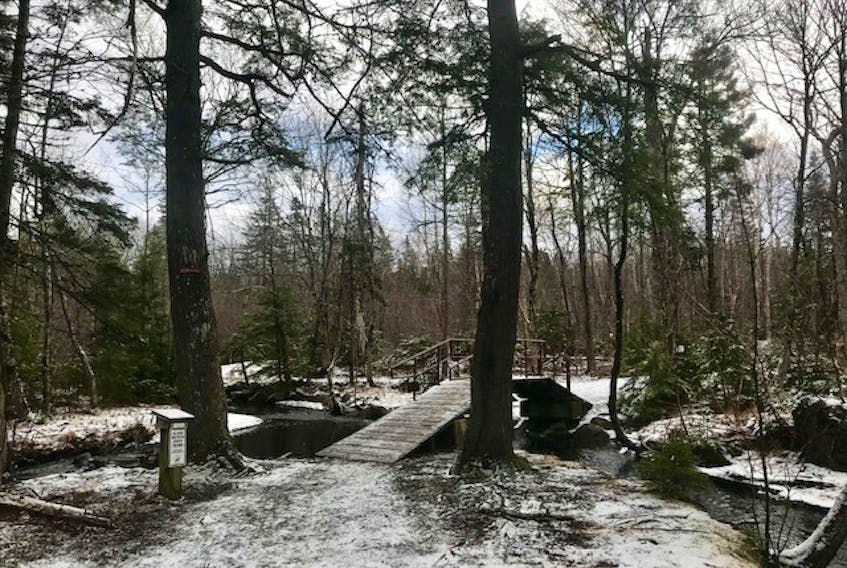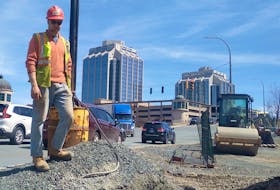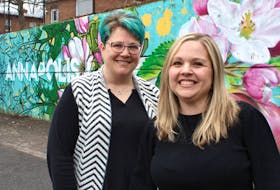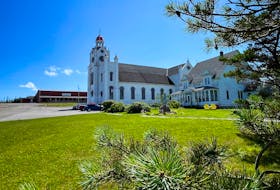For the past 20 years or so I have walked, occasionally snowshoed or skied and generally just enjoyed time spent in the beautiful wooded and brook-rich area minutes from my home in Ashby.
The Baille Ard Nature Trail is an accessible, multi-seasonal, multi-use, encapsulated countryside where the eastern hemlock trees are older than any part of the urban-built environment downstream.
Baille Ard is an old growth forest preserved in an urban environment.
In 2015, the Canadian Forest Service, an agency of the federal government, identified what they expect will develop the future of Canada’s urban forests. Fundamental to this is increased evidence showing urban forests and green spaces like Baille Ard can decrease chronic disease by encouraging physical activity and improve mental health and overall social health of citizens.
The health benefits of trees and green spaces has been investigated and studied both quantifiably and qualitatively for the past 30 years. Health benefits are myriad and the most commonly citied ways benefits occur include: the trees role in filtering air, increasing physical activity, reducing stress and increasing social cohesion within a community.
Because responsibility and management costs for urban green spaces are usually under municipal rule and health spending is a provincial responsibility, authorities making the investments usually do not see any financial savings in the health sector resulting from urban forestry investment.
As an example, the Baille Ard Trail lies within the heart of Sydney, is on land owned by the province and for the most part was developed and is maintained by a devoted group of volunteer citizens of the surrounding area.

Like the Coxheath Hills trail, a few kilometres outside of Sydney proper, and the Green Links trail in Rotary Park, hard-working, dedicated and committed volunteers did the majority of trail development.
Citizens across Canada are seeking true civic involvement and a voice in decision making.
This is now the case in the Cape Breton Regional Municipality.
Those involved with the Baille Ard, Coxheath and Rotary Park trails have helped promote and maintain forest values for well over 20 years. Community stewardship participation is not new in the CBRM but it deserves more recognition. In the case of the Baille Ard Trail, it needs a more solid commitment of ownership.
Approximately 80 per cent of Canadians live in urban communities of various sizes and many communities are increasingly seeing climate change impact them. In addition to creating livable environments, urban forests protect cities from increasing and longer lasting heat waves by shading, and through soil erosion control and water uptake, trees mitigate flood events. Cities serious about doing their role to mitigate climate change through geeenhouse gas reduction are now being more cautious when considering removing their living canopies.
The Canadian Forest Service says “urban forests can be viewed as an asset or a liability depending on the mandates of different disciplines” including “engineers, risk managers, ecologists, and recreation providers.” In addition more citizens with an interest in providing healthy green living spaces for themselves and future generations want a seat at the decision-making table.
This has not happened to the extent it should in the case of the Baille Ard Trail. Even in a small place like Sydney, the benefits of urban forests (which includes all our trees and green infrastructure, natural or planted) has been neglected in favour of a large-scale, engineered water damming system that consultants have said wouldn’t do much to handle a rainstorm event such as occurred in October 2016.
Canadian cities regardless of size are dynamic. Some grow, some shrink, some change; in industries, manufacturing, cultures of its people. What’s constant is a desire for most people to want to live in a healthy environment and the evidence shows urban trees and all greenery are part of this scenario. Municipalities should become more aware of the importance of this concept and develop strategies for the promotion of green infrastructure.
CBRM could be a prime example of how a small city is doing its part. If decision makers fail now they fail for future generations and it’s doubtful anyone wants that. Our multi-seasonal urban forest trail, the country in the city, is the envy of larger centres, let’s keep it that way.
Paul MacDougall is a local writer and senior instructor in health studies at Cape Breton University.









